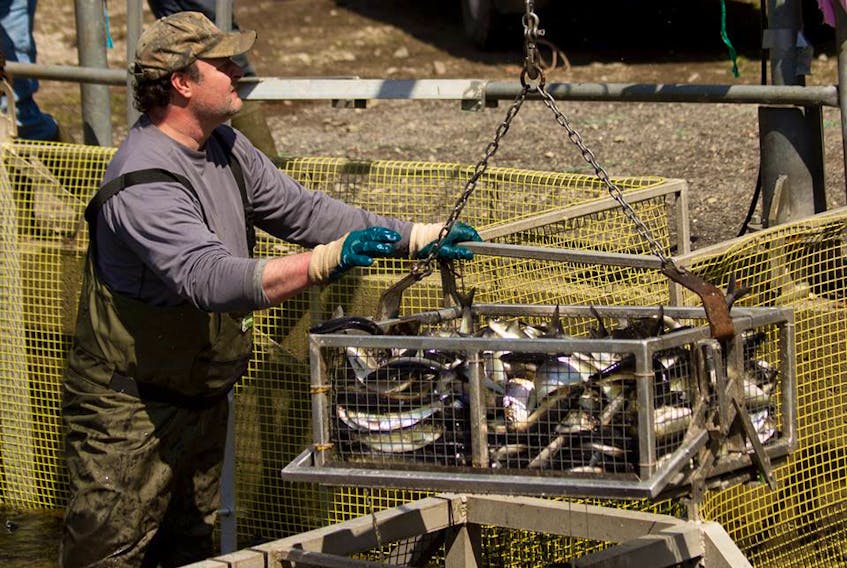TUSKET FALLS, N.S. — A fishery that provides lobster fishermen with a favourite bait for their catch is struggling with a declining population.
Gaspereau, also known as alewife and locally as kiack, swim up rivers in the spring to spawn in the still waters of lakes and return to sea in the fall. The Tusket River is a popular destination for these bony fish and during their spawning season each spring, thousands are caught by dip netters.
George Emin has been fishing kiack for 25 years and sits on the advisory board for the Tusket River Gaspereau Dip Net Association. He says what he earned from kiack fishing helped put his kids through college.
He blames Nova Scotia Power for the decline in kiack and says when the company worked on the Raynardton dam in 2011, it replaced the existing fish ladder with one that didn’t work.
He adds that when the issue was brought to their attention, they put a hole in the side of the new ladder to address the matter. Meanwhile, fish counts fell to 2,000 annually after being recorded as 800,000 several years before.
He says NS Power does their own counts and they say the ladder is working.
“If you’re getting 20,000-50,000 fish up, that’s not working,” he says.
He’s concerned about the fish ladder to be installed along with the Tusket dam replacement that’s now underway and says that when challenged, NS Power has provided no assurances as to what it will do if the ladder doesn’t work.
Operational procedures concerning the opening of the gates and the kiack fishery are also an issue for Emin.
On June 1, the day after kiack fishing season ended, he says the gate next to the fish ladder was opened and the strong flow prevented any fish from making it to the ladder.
“NS Power wasn’t supposed to do anything until the fish got up. Nothing is being done about protecting this resource for the kiack fishery,” said Emin.
“Fishermen are being blamed for overfishing, but NS Power is the problem with their dams and their ladders. Something has to change in order for us to have a sustainable fishery.
“The company is going to kill the kiack fishery and Dept. of Fisheries (DFO) is going to allow it,” he added.
NS POWER/DFO RESPOND
Patti Lewis, manager of communications for NS Power, addressed the performance of the fish ladder on the Carleton (Raynardton) reservoir, saying it had been resolved and DFO has been satisfied with its performance since the implementation of the resolution. (The fish ladder was modified in 2011, after the Carleton reservoir dam was replaced in late 2010, and the issues with its performance were rectified in 2012.)
“With regards to the Lake Vaughan fish ladder, Nova Scotia Power is not installing a new ladder but making minor adjustments to the vertical side walls of the existing ladder to match new ground elevations," she says. "The interior baffles, water flows, or rocks within the ladder are not changing."
She added that once the dam construction is complete, Nova Scotia Power is required, as per the DFO authorization for the project, to implement a monitoring plan for the fish ladder that ensures the pre-construction fish passage efficiency is maintained.
Alexandra McNab, communications advisor for Fisheries and Oceans Canada/Government of Canada, says DFO is aware of the industry’s concerns.
“If the fish ladder is not working as a result of the refurbishment, Nova Scotia Power Inc. (NSPI) will be required to implement measures to ensure upstream fish passage is achieved,” she says.
Once the refurbishment of the Tusket main dam is complete, DFO has also required that monitoring take place to ensure that the fish ladder efficiency is maintained.
She says no plans have been submitted to DFO with regard to modifying the fish ladder at this time.
“If any modifications are required during the dam refurbishment or subsequently, NSPI is required to submit plans to DFO for review prior to any implementation.”
DFO co-chairs the Yarmouth-Shelburne County gaspereau advisory committee with a fishing industry representative and representatives from the fishing industry, including the Tusket River Gaspereau Dip Netters Association, attend those meetings.
“Concerns raised by the fishing industry are discussed at these meetings and considered in DFO decisions,” says McNab.
OTHER FACTORS
Dwayne Robicheau has been fishing kiack since he was a child and remembers when bags of the fish sold for $5 or $6. The same size bag, containing 100 fish, now sells for $55.
He says there are several factors behind the declining kiack population, including the price of lobster, as kiacks are a popular bait for lobster fishermen.
“If lobster goes up, so does the price of bait and there’s more poaching and overfishing,” says Robicheau.
Last year was the worst he’s ever seen. He shares Emin’s concerns about the Tusket dam fish ladder and says it’s no longer adequate.

Another huge issue impacting the kiack fishery is the massive influx of cormorant that feed on them. Robicheau says the number of the hungry birds has gone up 1,000 per cent. The birds can eat a pound of fish each day.
It’s not only this region that’s struggling with the cormorant problem. Earlier this year, Ontario's Ministry of Natural Resources and Forestry sought feedback from staff on the creation of an annual cormorant hunting season, with hunters permitted to bag 50/day. That would make Ontario the only province in Canada to remove the bird from protected status.
The aboriginal fishery is also scooping up fish during the annual run.
With all the challenges facing successful reproduction of kiack, Robicheau doesn’t hold much hope for them if things continue the way they are.
He says they are witnessing the end of a species.









